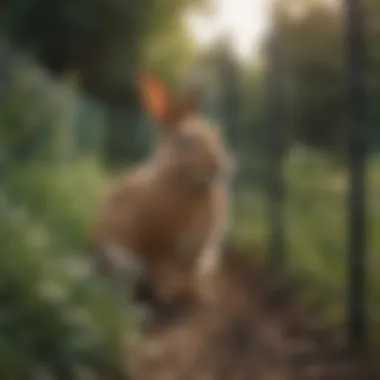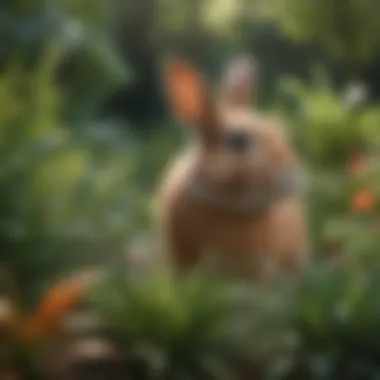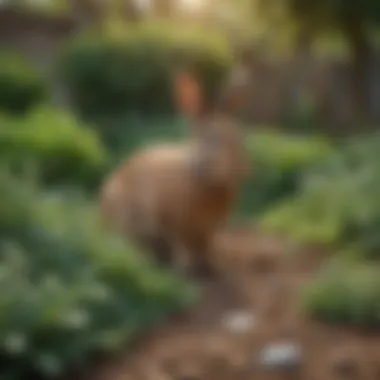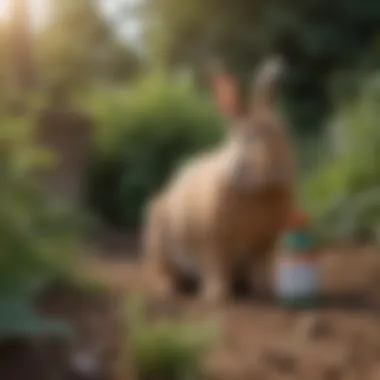Effective Strategies to Keep Rabbits Out of Your Garden


Intro
Creating a thriving garden is a rewarding endeavor. However, many gardeners face a common nuisance: rabbits. These creatures can cause considerable damage to plants, particularly young seedlings and tender vegetables. Understanding effective strategies to deter them is crucial for preserving your garden's integrity.
Rabbits are drawn to gardens not only for food but also for potential shelter. They are herbivores, which means they primarily feed on greens. Thus, implementing the right strategies can not just protect your plants but also create an environment less attractive to these animals.
By incorporating various tactics such as physical barriers, natural repellents, and behavioral approaches, homeowners can significantly reduce the likelihood of rabbits invading their garden spaces. This article will delve into effective measures, illustrating how you can safeguard your garden from unwanted furry visitors.
Understanding the Problem
Understanding the problem of rabbit invasion in gardens is critical for effective management. Gardeners often spend considerable time and resources nurturing their plants, only to find them decimated by these small herbivores. By comprehending both the dynamics of the rabbit population and the impact they have on gardens, homeowners can implement targeted strategies to protect their green spaces.
The Rabbit Population Dynamics
Rabbit populations can fluctuate based on various environmental and social factors. They reproduce rapidly; a single pair can lead to dozens of offspring in a year, which can quickly exacerbate the problem in residential areas. Factors such as food availability, presence of predators, and habitat conditions play roles in determining population density. In urban settings, the abundance of gardens provides a continuous food supply. Moreover, mild winters can also contribute to higher survival rates. Understanding these dynamics enables gardeners to anticipate potential invasions and take preemptive measures.
Impact of Rabbits on Gardens
Rabbits pose significant threats to gardens by consuming a wide variety of plants. They prefer tender greens, seedlings, and young plants, resulting in visible destruction. Commonly affected plants include lettuce, carrots, and other leafy vegetables. Besides direct damage to plants, rabbits can also impact the ecosystem within the garden. Their foraging can alter the growth conditions and balance of competing species, potentially leading to a decline in biodiversity.
"Understanding rabbit behavior and population dynamics is crucial for any gardener hoping to protect their garden effectively."
In addition to physical damage, rabbit droppings can attract pests and influence soil health negatively. Therefore, addressing this problem at its root by comprehensively understanding the rabbits' habits can lead to a more flourishing garden.
Physical Barriers
Physical barriers are a primary line of defense against rabbits. These barriers create a boundary that keeps these animals away from gardens, thus protecting plants and flowers from excessive nibbling. The effectiveness of physical barriers lies in their ability to deter rabbits from accessing your garden without causing harm to them or the environment. By establishing a clear, unobstructed separation between rabbits and your plants, you can ensure the longevity and health of your garden.
Fencing Solutions
Height and Depth Requirements
When it comes to fencing solutions, height and depth are crucial factors. To deter rabbits successfully, fences should be a minimum of 3 feet tall, although 4 feet can provide extra assurance. The addition of depth is equally important; burying the fence at least 6 to 10 inches underground can prevent rabbits from digging underneath. This specific requirement effectively reduces the likelihood of rabbits breaching the fence and gaining access to your garden. Ensuring appropriate height and depth can be a favorable choice, as it often leads to long-term success in keeping rabbits at bay without the use of chemical deterrents.
Materials to Consider
The choice of materials influences both durability and efficiency of the barrier. Common options include wire mesh, chain link, or PVC fencing. Wire mesh is often the most recommended due to its strength and ability to adapt to various garden shapes. It is also relatively cost-effective and readily available. A unique feature of using wire mesh is that it can be cut to size, making it suitable for various garden configurations. However, it’s essential to consider potential rusting and degradation over time, which may necessitate replacement or maintenance.
Row Covers and Other Protective Covers
Choosing the Right Material
Selecting the right material for row covers or protective covers is vital. Lightweight fabrics, such as garden fleece or mesh, allow sunlight and moisture to penetrate while providing a physical barrier against rabbits. This characteristic makes such materials suitable for delicate plants that need protection. An important consideration is the balance between breathability and sturdiness of the material; too thick may suffocate plants, while too thin may not act effectively against rabbits. Thus, finding a material that offers both protection and plant health is beneficial for any gardening enthusiast.
Installation Techniques
Effective installation techniques enhance the protective role of row covers. It’s essential to secure covers well to prevent rabbits from slipping underneath or pushing through. Anchoring covers with soil, stakes, or weights can offer stability against wind and animal interference. A strong point to consider is that well-installed protective covers not only deter rabbits but also protect against other pests and adverse weather conditions. Therefore, attention to installation details can be a significant factor in the overall success of your gardening efforts.
Natural Repellents
Natural repellents offer a compassionate approach to keeping rabbits away from gardens. They stand as alternatives to more aggressive methods, such as traps or poisons. Leveraging herbs and predator scents can create an environment that is less appealing to rabbits without causing harm. Implementing these strategies might even enhance the biodiversity in your garden, making it a more rich ecosystem.
Herbal Deterrents
Common Herbs that Repel Rabbits
Certain herbs naturally deter rabbits due to their strong scents. For example, rosemary, sage, and lavender are effective. These plants release essential oils that rabbits find unpleasant. Incorporating these herbs can be a beneficial choice for any garden. By having them planted among vegetables or flowers, gardeners can create a less hospitable environment for rabbits. However, these plants need regular care and attention for optimal growth.


In addition, using these herbs can enhance the character of the garden space. They also attract beneficial insects, which support pollination. While they can deter rabbits, one disadvantage is that they may not have a strong enough scent if not well-maintained.
Effective Application Methods
Applying herbal deterrents effectively is essential to their success. One method is to crush the fresh leaves of the herbs and scatter them around the garden. This releases their scent into the air, creating a barrier that rabbits might avoid. Other options include creating natural sprays using essential oils derived from these herbs mixed with water.
The key characteristic of these application methods is their simplicity. Many homeowners may find them convenient and easy to utilize. However, a limitation exists in their effectiveness. Frequent reapplication is necessary, especially after rain, to maintain their deterrent quality.
Predator Scents and Their Usage
Types of Repellent Scents
Utilizing predator scents is another effective strategy. Scents of animals like foxes or coyotes are typically strong and can discourage rabbits from approaching. Products like fox urine can be purchased from garden supply stores. The main advantage of using such scents is their potent ability to mimic a predator's presence in the area. This natural fear can lead rabbits to move away from the garden.
However, one should consider the local wildlife as well. This method may not be suitable in areas where the scent could interfere with native animals. Plus, some gardeners feel uneasy about using such materials, making it less popular.
Application Frequency
The frequency of applying predator scents is crucial for maintaining their effectiveness. Ideally, gardeners should apply these scents every few weeks, or after heavy rain, to ensure a continuous deterrent effect. The ongoing presence of these scents can maintain the perceived risk for rabbits, encouraging them to avoid the area altogether.
This method, while effective, requires consistent effort and monitoring. Homeowners must stay mindful of the application schedule to achieve the desired result without gaps in protection.
In summary, natural repellents provide an effective way to manage rabbit populations in gardens. These strategies can safeguard plants, promote a healthier garden ecosystem, and reflect a more ethical approach to wildlife management.
Natural repellents, such as herbs and predator scents, pave the way for non-invasive means of protecting gardens while considering the well-being of local wildlife.
Companion Planting
Companion planting is a critical strategy when it comes to protecting your garden from rabbits. This method involves planting certain types of plants in close proximity to each other for mutual benefits. The idea is not only to enhance growth but also to deter unwanted herbivores. When you strategically select plants that rabbits find unappealing, you create a natural barrier that serves to protect your more delicate plants.
Rabbits have selective feeding habits. They often avoid plants with strong odors or bitter tastes. By incorporating these types of plants into your garden, you can make it less attractive to these animals, thus safeguarding your garden.
Plants that Deter Rabbits
Examples of Companion Plants
Some effective companion plants include lavender, sage, and marigolds. Lavender is known for its pleasing fragrance to humans but is quite off-putting to rabbits. This plant not only adds beauty to your garden but also thrives in various soil conditions, making it a versatile choice.
Sage also serves as an excellent companion plant. Its strong scent repels rabbits while attracting beneficial insects that promote pollination. Using sage can enhance both your garden's health and its appeal.
Marigolds are another popular option. Their bright colors can beautify your garden while their scent can deter rabbits. They are also easy to grow and can thrive even in less-than-perfect conditions.
A unique feature of these plants is their strong aromatic properties, which hinder rabbits' feeding. However, it should be noted that while these plants help, they should not be solely relied upon.
Planting Strategies
Selecting the right planting strategy is essential to maximize the benefits of companion planting. A recommended approach is intercropping, where you mix pest-deterring plants with your main crops. This minimizes the chance of rabbits identifying specific plants as targets.
Cluster planting can also be effective. This involves grouping companion plants together to create a stronger barrier effect against rabbits. Positioning the more vulnerable plants within the cluster can provide them enhanced protection.
An advantage of these strategies is that they create a hospitable environment for beneficial insects, helping to control the garden pest population. However, one must also be wary of overcrowding and competition for nutrients among plants.
Enhancing Planting Layouts
To further deter rabbits, consider enhancing the layout of your garden. A balanced design can improve visibility and reduce hiding places for rabbits while making it easier to implement other deterrent strategies. Arranging your planting zones so that strong-smelling and bitter-tasting plants are positioned closest to the edges can help in reducing rabbit access.
Strategic layout can significantly minimize the impact of rabbit activity in gardens.


By keeping an eye on your layout and maintaining it, you will create an environment less conducive to rabbit habitation. Overall, companion planting not only enriches your garden but also utilizes natural deterrents to keep unwanted wildlife at bay.
Behavioral Approaches
Understanding behavioral approaches is vital for effectively managing rabbit populations in garden spaces. These strategies focus on modifying the environment and utilizing rabbits' natural tendencies to deter them from making your garden a habitat. Implementing these methods can lead to a significant decrease in rabbit activity while minimizing harm to wildlife.
Disruption Techniques
Disruption techniques involve actions that disturb rabbits' routines and scare them away from specific areas. For instance, frequent movements around the garden or the use of sound emitters can create an unwelcoming environment for these creatures. By introducing disturbances, you can effectively make the garden less appealing to rabbits, thereby protecting your plants.
Regular activity in the garden not only disrupts their feeding patterns but also encourages them to seek food sources elsewhere. One effective method is to set up wind chimes or other noise-producing devices. The unpredictability of these sounds can startle rabbits, making them less inclined to come near. Additionally, setting up motion-activated sprinklers can create sudden bursts of water that can frighten rabbits and help maintain your garden's safety.
Habitat Management
Habitat management is crucial for controlling the rudimentary aspects of rabbits' living conditions around your garden. Two main factors play a significant role: reducing shelter areas and managing food sources.
Reducing Shelter Areas
Reducing shelter areas involves making your garden less accommodating for rabbits. This can be achieved by eliminating dense bushes, tall grass, and piles of debris where rabbits can hide. By maintaining a well-manicured garden with fewer hidden spots, you effectively reduce the likelihood of rabbits taking up residence.
This approach is beneficial as it directly impacts the rabbit's ability to camouflage itself and feel secure. Less shelter equals a higher risk for these creatures, compelling them to leave the area in search of a more suitable environment. While this may take some time, the long-term benefits far outweigh any short-term disruption to your garden layout.
Managing Food Sources
Managing food sources is another critical aspect of habitat management. This involves being strategic about your garden layout and what plants you choose to grow. By selecting less palatable plants for rabbits, you can discourage them from venturing into your space. For example, herbs like rosemary and sage are known to deter rabbits due to their strong scents.
This tactic not only protects your primary plant choices but also fosters a garden dynamic that discourages rabbit visits. However, it is essential to be aware that no method is entirely foolproof. While this can effectively reduce garden visits, adjusting to this strategy may require periodic reevaluation. Regularly inspecting your garden and adjusting the plant choices according to seasonal changes or modifying your strategies can ensure ongoing effectiveness in keeping rabbits at bay.
Monitoring and Adapting Techniques
Effective gardening involves not only the initial implementation of strategies but also continuous observation and adjustments. Monitoring and adapting techniques is vital for ensuring that your efforts to deter rabbits are successful and remain effective over time. This section discusses the importance of keeping an eye on your garden and refining your approaches as necessary.
A vigilant gardener will be aware of rabbit behaviors, seasonal changes, and how their measures are functioning. If a certain barrier stops working, or if a natural repellent appears ineffective, adjustments are needed. Maintaining a proactive approach can prevent long-term damage to your plants.
By regularly assessing your methods, you can identify what works best and eliminate unnecessary methods that do not yield results. This evaluation leads to more sustainable practices and ensures resources are used effectively.
Observation and Data Gathering
Observation and data gathering are foundational elements of effective garden management. They involve keeping track of rabbit activity, growth patterns of plants, and the overall health of the garden. Regularly checking for signs of rabbit presence, such as droppings or nibbled leaves, provides immediate feedback on whether your current strategies are working.
Here are some tips for effective observation:
- Set up a schedule for routine checks. Frequent monitoring can catch issues early.
- Keep a garden diary. Documenting observations in detail helps track changes over time.
- Utilize technology. Consider using cameras to monitor wildlife activity when you are not present.
By gathering data, gardeners will have a clearer picture of their situation, which guides future actions.
Evaluating Effectiveness of Strategies
Criteria for Success
Establishing criteria for success is essential to evaluate the strategies employed in the garden effectively. These criteria might include reduced rabbit activity, improved plant health, and visual appeal of the garden. A beneficial aspect of this criteria setting is that it allows for measurable outcomes.
Key characteristics of success criteria include:
- Measurable: Clear metrics ensure that you can track progress over time.
- Relevant: Focus on factors that truly impact rabbit behavior and garden health.
These criteria become a compelling choice for gardeners as they encourage a structured approach. Unique features include the ability to adapt thresholds based on seasons or changing conditions in the garden. If criteria are not met, one can easily pinpoint areas for improvement.


Adjusting Methods as Necessary
Adjusting methods as necessary is another critical aspect of effective garden management. As observed conditions evolve, strategies should also change to keep up with the environment. This flexibility is vital in maintaining a barrier against rabbits.
Key characteristics of this method adjustment include:
- Responsiveness: Tailoring methods to newer insights allows for resilience.
- Continuous Improvement: Each adjustment can enhance the overall effectiveness of strategies.
The unique feature of adjusting methods lies in the gardener’s ability to learn and adapt over time. This can lead to improved efficacy of all efforts. The advantage comes from evolving as new challenges arise. However, it requires patience and keen attention to changes both in rabbit behavior and garden health.
The Ethical Consideration
The topic of ethical consideration is central when discussing strategies to prevent rabbits from inhabiting your garden. The human-wildlife interface is a complex landscape, where both interests must be respected. While protecting your plants is crucial, it is equally important to approach the problem with a sense of responsibility and respect for the rabbits as living creatures. Taking a thoughtful, humane approach can lead to sustainable gardening practices that do not compromise the welfare of these animals.
Wild rabbits serve a role in their ecosystems, and ethical considerations revolve around minimizing harm while discouraging their presence in your garden. This approach requires careful planning and implementation of strategies that prioritize the well-being of the animal population, ensuring that interventions do not result in suffering or unnecessary displacement.
The balance between effective pest control and the ethical treatment of wildlife can create a more harmonious coexistence, benefiting both the gardener and the rabbits. Understanding the implications of our actions allows us to cultivate gardens that are not only productive but also ethically sound.
Humane Treatment of Wildlife
Humane treatment involves using methods that discourage rabbits without causing injury. This can include using non-lethal barriers like fences that are tall enough to deter jumping, or growths of specific plants that rabbits tend to avoid, rather than using traps or toxins. Prioritizing these strategies shows a commitment to ethical gardening.
Implementing a humane approach encourages a dialogue about coexistence. Garden owners can easily integrate practical barriers into their landscaping without resorting to harmful methods. It embraces a mindset that respects the balance of nature while maintaining the aesthetics and health of the garden space.
Some key aspects include:
- Providing natural habitats away from gardens to redirect rabbits.
- Utilizing mulch and cover crops that deter them.
- Seeking out community resources for more knowledge on humane practices.
Through these considerations, homeowners can ensure they employ humane tactics, aligning their gardening objectives with ethical principles.
Long-term Solutions vs. Short-term Fixes
When addressing rabbit infestations, it is essential to distinguish between long-term solutions and temporary fixes. Short-term methods, such as occasional spraying of repellents, may provide immediate relief but often fail to eliminate the underlying issues that attract bunnies to gardens in the first place.
Long-term solutions involve creating a garden environment unattractive to rabbits. This includes landscaping choices that exclude plants they prefer, alongside implementing comprehensive barriers.
A few notable long-term strategies are:
- Thoughtful plant selection that incorporates rabbit-repelling species.
- Employing fencing systems that go underground to prevent burrowing.
- Ongoing monitoring of rabbit activity and adjusting methods as needed.
"Adopting long-term strategies not only benefits your garden but also faors the local wildlife, ensuring a balance where both can thrive."
Closure
In concluding the exploration of effective strategies to prevent rabbits from inhabiting your garden, it is crucial to recognize the multifaceted nature of this issue. Addressing the challenge posed by rabbits requires a combination of physical barriers, natural repellents, and behavioral approaches. Each method outlined in this guide presents unique advantages and should be tailored based on individual needs and specific garden layouts.
Summary of Effective Methods
A synthesis of effective methods reveals a spectrum of solutions:
- Physical Barriers: Utilizing robust fencing systems can create an immediate obstacle to prevent rabbits from accessing the garden. Consider fencing that is at least three feet high and buried about a foot deep to effectively deter burrowing.
- Natural Repellents: Employ herbs that repel rabbits, such as lavender and rosemary. Their aromatic properties can confuse or deter these animals from approaching your garden.
- Companion Planting: Strategically planting rabbit-repelling species alongside more vulnerable plants enhances overall garden resilience and reduces attractiveness to rabbits.
- Behavioral Approaches: Implementing habitat management can drastically reduce the likelihood of rabbits settling near your garden. Removing any potential food sources or hiding spots is essential.
These strategies contribute significantly to maintaining a healthy garden ecosystem while also ensuring the long-term viability of your plants against rabbit incursions.
Final Thoughts on Garden Protection
Reflecting on the broader implications of garden protection against rabbits emphasizes a conscientious approach to wildlife management. Gardeners should opt for humane deterrents that are as effective as they are ethical. Choosing methods that do not harm local wildlife aligns with a sustainable gardening philosophy, fostering a more harmonious relationship with nature.
Implementing a mixture of tactics will likely yield the best results. Pay attention to the unique dynamics within your garden space. Adaptability and consistent monitoring of strategies will enable you to navigate the challenges posed by an ever-evolving rabbit population.
By employing these preventive measures, you not only protect your garden investments but also contribute to a balanced ecosystem. For additional information, resources may be found at Wikipedia, Britannica, Reddit, and Facebook.
It is essential to remember that a well-protected garden not only flourishes but also serves as a vital component of urban biodiversity.



